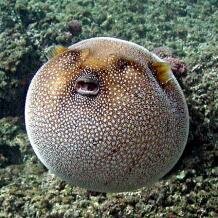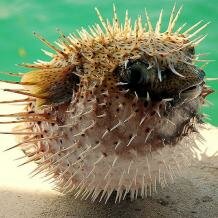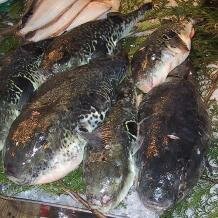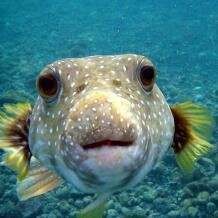Topic: Pufferfish (and inflation)
Pufferfish are some of the most extraordinary fish to have evolved, especially because of their capacity to swallow water and inflate themselves to something like a football. Not only that but some representatives can be deadly to the unwary diner...
Pufferfish (Tetraodontidae), a mainly tropical teleost family with more than 120 species, are some of the most extraordinary fish to have evolved. Particularly remarkable is their capacity to swallow water and inflate themselves to something that looks like a football. But they are not the only fish capable of inflation and they show other convergences, too, in part related to defence.
Defence mechanisms
Most fish if provoked will undergo a characteristic escape manoeuvre that depends on a relatively flexible body. The pufferfish group, however, are built more like a box, and actually swim by using a combination of fins. And while this allows for high manoeuvrability, it is not exactly fast, making puffers relatively easy targets for predators. So when threatened they sit it out, assisted not only by inflation but also by mechanical defences and a particularly powerful neurotoxin.
Inflation
 Upon encountering a hungry predator, pufferfish rapidly swallow mouthfuls of water (or air when removed from the water) that are pumped into an extremely expandable stomach. The resulting increase in size makes them harder to swallow. Not surprisingly, to achieve this drastic change in shape there has been a radical re-arrangement of the internal skeleton. The ribs and pelvic girdle have been lost (within the order Tetraodontiformes, the loss of the pelvis has occurred at least twice), while the pectoral girdle and head have undergone significant modifications that function in the pumping mechanism. Furthermore, the skin of pufferfish is highly extensible.
Upon encountering a hungry predator, pufferfish rapidly swallow mouthfuls of water (or air when removed from the water) that are pumped into an extremely expandable stomach. The resulting increase in size makes them harder to swallow. Not surprisingly, to achieve this drastic change in shape there has been a radical re-arrangement of the internal skeleton. The ribs and pelvic girdle have been lost (within the order Tetraodontiformes, the loss of the pelvis has occurred at least twice), while the pectoral girdle and head have undergone significant modifications that function in the pumping mechanism. Furthermore, the skin of pufferfish is highly extensible.
However, they are not the only members of the Tetraodontiformes that show this rather bizarre behaviour. The closely related porcupinefish (also called spiny puffers) in the family Diodontidae, which might be confused with the pufferfish but possess larger spines, are also capable of inflating themselves. While most likely inflation behaviour originated in the common ancestor of these two sister taxa, it has convergently evolved a second time within the Tetraodontiformes. At least one genus of filefish (Brachaluteres) shows poorly developed inflation behaviour, while lacking any of the morphological specialisations seen in puffers. The abdomen of Brachaluteres is not extensible, but can become somewhat turgid and inflated after swallowing water.
Remarkable as the well-developed inflation behaviour seen in pufferfish is, its evolutionary origin may not be particularly mysterious, because two functionally similar behaviours that also involve buccal compression are common in the Tetraodontiformes. All taxa show a “coughing” behaviour to spit out unwanted objects and most are also very adept at “blowing” strong jets of water out of their mouths, such as to uncover, manipulate and clean prey. Coughing, blowing and inflation are all based on a similar cycle of expanding and compressing the buccal cavity in order to draw water into the mouth and force it out again, and the muscle contraction patterns are broadly conservative.  The main difference is that inflation involves the pumping of water into the stomach and not out of the mouth. The underlying modest changes in morphology and motor patterns generally suggest “that the behaviours may represent a transformation series of increasingly specialised behaviours, from coughing, to water blowing and finally to inflation” (Wainwright and Turingan 1997, Evolution, vol. 51, pp. 506-518).
The main difference is that inflation involves the pumping of water into the stomach and not out of the mouth. The underlying modest changes in morphology and motor patterns generally suggest “that the behaviours may represent a transformation series of increasingly specialised behaviours, from coughing, to water blowing and finally to inflation” (Wainwright and Turingan 1997, Evolution, vol. 51, pp. 506-518).
Although characterising the Tetraodontidae and Diodontidae, a limited degree of inflation of the body cavity is also found in some other groups of fish. Catsharks in the genus Cephaloscyllium (Scyliorhinidae) are commonly known as swellsharks as they swallow water or air to inflate themselves, also as a defence against predators. When the swellshark (Cephaloscyllium ventriosum) feels threatened, it apparently bends its body, seizes its tail with its teeth and sucks in water, thus almost doubling in size. Anecdotal evidence furthermore reports abdominal inflation in the South African pelagic goby (Sufflogobius bibarbatus). The scales covering its abdomen are encased in separate skin pockets, so they can slide apart upon inflation.
Mechanical defences
 Pufferfish also rely on mechanical defences. These include a hard carapace of joined plates, which has evolved at least twice in the Tetraodontiformes. For the most part, pufferfish seem to be almost impregnable.
Pufferfish also rely on mechanical defences. These include a hard carapace of joined plates, which has evolved at least twice in the Tetraodontiformes. For the most part, pufferfish seem to be almost impregnable.
Some species also have spines (which are, of course, convergently employed in defence by numerous animals). However, they are not as large and conspicuous as those of the porcupinefish, which radiate outwards upon inflation, but rather small, almost sandpaper-like.
Tetrodotoxin
In Japanese cuisine, Fugu (which refers to several species of pufferfish) is notorious because if improperly prepared its consumption can have fatal consequences.  Some body parts, particularly the internal organs, contain high concentrations of one of the most powerful toxins found in nature, tetrodotoxin (which takes its name from the Tetraodontiformes). This alkaloid, which is up to 1200 times more potent than cyanide and has no known antidote, blocks action potentials in nerve cells by binding to voltage-gated sodium channels, thus causing motor paralysis and ultimately death from suffocation within minutes. It is found in several pufferfish genera and sometimes associated with bright colours and distinct markings, thus probably representing one of numerous examples of aposematism.
Some body parts, particularly the internal organs, contain high concentrations of one of the most powerful toxins found in nature, tetrodotoxin (which takes its name from the Tetraodontiformes). This alkaloid, which is up to 1200 times more potent than cyanide and has no known antidote, blocks action potentials in nerve cells by binding to voltage-gated sodium channels, thus causing motor paralysis and ultimately death from suffocation within minutes. It is found in several pufferfish genera and sometimes associated with bright colours and distinct markings, thus probably representing one of numerous examples of aposematism.  Interestingly, tetrodotoxin is not produced by the fish themselves but by endogenous bacteria (e.g. species in the genera Vibrio and Pseudomonas), which are ingested with food. The mechanism by which the fish avoid self-poisoning revolves around a fascinating story of molecular convergence. Tetrodotoxin resistance is achieved by amino acid changes in all eight types of sodium channel, which substantially reduce affinity to the toxin. Intriguingly, these changes evolved independently in four phylogenetically diverse pufferfish species, but involve only very few sites, suggesting that selection for normal channel function strongly limits the possibilities for resistance-conveying mutations. Tetrodotoxin resistance thus represents “an example of natural selection acting upon a complete gene family, repeatedly arriving at a diverse but limited number of adaptive changes within the same genome” (Jost et al. 2008, Molecular Biology and Evolution, vol. 25, pp. 1016-1024).
Interestingly, tetrodotoxin is not produced by the fish themselves but by endogenous bacteria (e.g. species in the genera Vibrio and Pseudomonas), which are ingested with food. The mechanism by which the fish avoid self-poisoning revolves around a fascinating story of molecular convergence. Tetrodotoxin resistance is achieved by amino acid changes in all eight types of sodium channel, which substantially reduce affinity to the toxin. Intriguingly, these changes evolved independently in four phylogenetically diverse pufferfish species, but involve only very few sites, suggesting that selection for normal channel function strongly limits the possibilities for resistance-conveying mutations. Tetrodotoxin resistance thus represents “an example of natural selection acting upon a complete gene family, repeatedly arriving at a diverse but limited number of adaptive changes within the same genome” (Jost et al. 2008, Molecular Biology and Evolution, vol. 25, pp. 1016-1024).
 The employment of tetrodotoxin as a defence (or sometimes predatory venom) is rampantly convergent, remarkably including marine as well as non-marine organisms. In the marine realm, it has so far been isolated from another fish (the marine goby Yongeichthys criniger), marine worms of different phyla (flatworms, ribbon worms, arrow worms and annelids), blue-ringed octopuses (genus Hapalochlaena), various genera of marine snails, crustaceans (the horseshoe crab Carcinoscorpius rotundicauda as well as xanthid crabs from different genera) and starfish (genus Astropecten). Beyond the oceans, the toxin is found in a wide range of amphibians from different families, particularly newts in the genus Taricha and frogs in the genus Atelopus. As it seems likely that their tetrodotoxin is also of bacterial origin, the symbiosis between tetrodotoxin-producing bacteria and animals, as well as the resistance of these animals to the toxin, has probably evolved independently several times. Interestingly, some predators of these poisonous animals might have convergently acquired tetrodotoxin resistance. Garter snakes (Thamnophis sirtalis) that prey on California newts (Taricha torosa) can eat them without any harm done, whereas garter snake populations that do not encounter the newts in the wild are poisoned when fed newts in the laboratory.
The employment of tetrodotoxin as a defence (or sometimes predatory venom) is rampantly convergent, remarkably including marine as well as non-marine organisms. In the marine realm, it has so far been isolated from another fish (the marine goby Yongeichthys criniger), marine worms of different phyla (flatworms, ribbon worms, arrow worms and annelids), blue-ringed octopuses (genus Hapalochlaena), various genera of marine snails, crustaceans (the horseshoe crab Carcinoscorpius rotundicauda as well as xanthid crabs from different genera) and starfish (genus Astropecten). Beyond the oceans, the toxin is found in a wide range of amphibians from different families, particularly newts in the genus Taricha and frogs in the genus Atelopus. As it seems likely that their tetrodotoxin is also of bacterial origin, the symbiosis between tetrodotoxin-producing bacteria and animals, as well as the resistance of these animals to the toxin, has probably evolved independently several times. Interestingly, some predators of these poisonous animals might have convergently acquired tetrodotoxin resistance. Garter snakes (Thamnophis sirtalis) that prey on California newts (Taricha torosa) can eat them without any harm done, whereas garter snake populations that do not encounter the newts in the wild are poisoned when fed newts in the laboratory.
Durophagy
 The name Tetraodontidae, meaning four teeth, refers to the large, pavement-like tooth plates that are present in the upper and lower jaw of pufferfish. These tooth plates are employed to crush hard-bodied prey, such as molluscs and crustaceans. This is the dominant feeding mechanism in the Tetraodontiformes and here has been most extensively studied in the queen triggerfish (Balistes vetula).
The name Tetraodontidae, meaning four teeth, refers to the large, pavement-like tooth plates that are present in the upper and lower jaw of pufferfish. These tooth plates are employed to crush hard-bodied prey, such as molluscs and crustaceans. This is the dominant feeding mechanism in the Tetraodontiformes and here has been most extensively studied in the queen triggerfish (Balistes vetula).
However, durophagy has evolved independently in several groups of fish (as well as in the other vertebrate groups). Fish in the family Sparidae, such as porgies and the Atlantic sheepshead (Archosargus probatocephalus) also use their oral teeth as crushers, whereas a number of durophagous teleosts have modified their pharyngeal jaws, a second set of teeth further down the throat. Intriguingly, durophagy is found in cartilaginous fish as well (e.g. eagle rays, horn sharks and ratfish), where morphological and functional adaptations of the teeth and jaw allow for the generation of the large forces needed to break the protective armour of hard-shelled prey.
Genomes
The haploid genomes of pufferfish are the smallest vertebrate genomes measured to date. With about 365 million base pairs (Mb), the genome of the Japanese pufferfish (Takifugu rubripes) is only about one-ninth the size of the human genome,  and a recent study suggested that the bandtail puffer (Sphoeroides spengleri) genome might be even smaller. Despite this remarkable compaction, the gene repertoire of pufferfish is highly similar to other fish and vertebrates in general, implying that they have lost large amounts of non-coding DNA (e.g. interspersed repeats and pseudogenes) that litters the genomes of mammals. This illustrates the principle that functional DNA sequences are evolutionarily conserved and identifiable across species, whereas non-functional DNA is not subject to evolutionary constraints. So the fugu genome is basically like the human one but with less junk; the ‘father’ of fugu genome research, Sydney Brenner, referred to it as a Reader’s Digest version of its human counterpart. As the Diodontidae possess larger genomes (about 800 Mb), it is assumed that the Tetraodontidae began to lose DNA after diverging from their sister group. A potential selective advantage of the genome compaction is still being debated, but as genome size is often associated with traits such as metabolic and development rates, is has been speculated that the pufferfish with their high reproductive rates might benefit from shorter development times (as a result of less DNA needing to be replicated).
and a recent study suggested that the bandtail puffer (Sphoeroides spengleri) genome might be even smaller. Despite this remarkable compaction, the gene repertoire of pufferfish is highly similar to other fish and vertebrates in general, implying that they have lost large amounts of non-coding DNA (e.g. interspersed repeats and pseudogenes) that litters the genomes of mammals. This illustrates the principle that functional DNA sequences are evolutionarily conserved and identifiable across species, whereas non-functional DNA is not subject to evolutionary constraints. So the fugu genome is basically like the human one but with less junk; the ‘father’ of fugu genome research, Sydney Brenner, referred to it as a Reader’s Digest version of its human counterpart. As the Diodontidae possess larger genomes (about 800 Mb), it is assumed that the Tetraodontidae began to lose DNA after diverging from their sister group. A potential selective advantage of the genome compaction is still being debated, but as genome size is often associated with traits such as metabolic and development rates, is has been speculated that the pufferfish with their high reproductive rates might benefit from shorter development times (as a result of less DNA needing to be replicated).
Their genome reduction makes pufferfish suitable models for the study of genome evolution and comparative genomics, and the complete gene sequences of two species (T. rubripes and Tetraodon nigroviridis) have been published so far. A comparison of parts of these sequences showed that a green-sensitive opsin gene has convergently experienced a loss of function in both pufferfish lineages. Opsins are small transmembrane proteins important in vertebrate colour vision, but a selective benefit of the loss has not yet been identified.
Cite this web page
Map of Life - "Pufferfish (and inflation)"
https://mapoflife.org/topics/topic_437_pufferfish-and-inflation/
July 31, 2017

